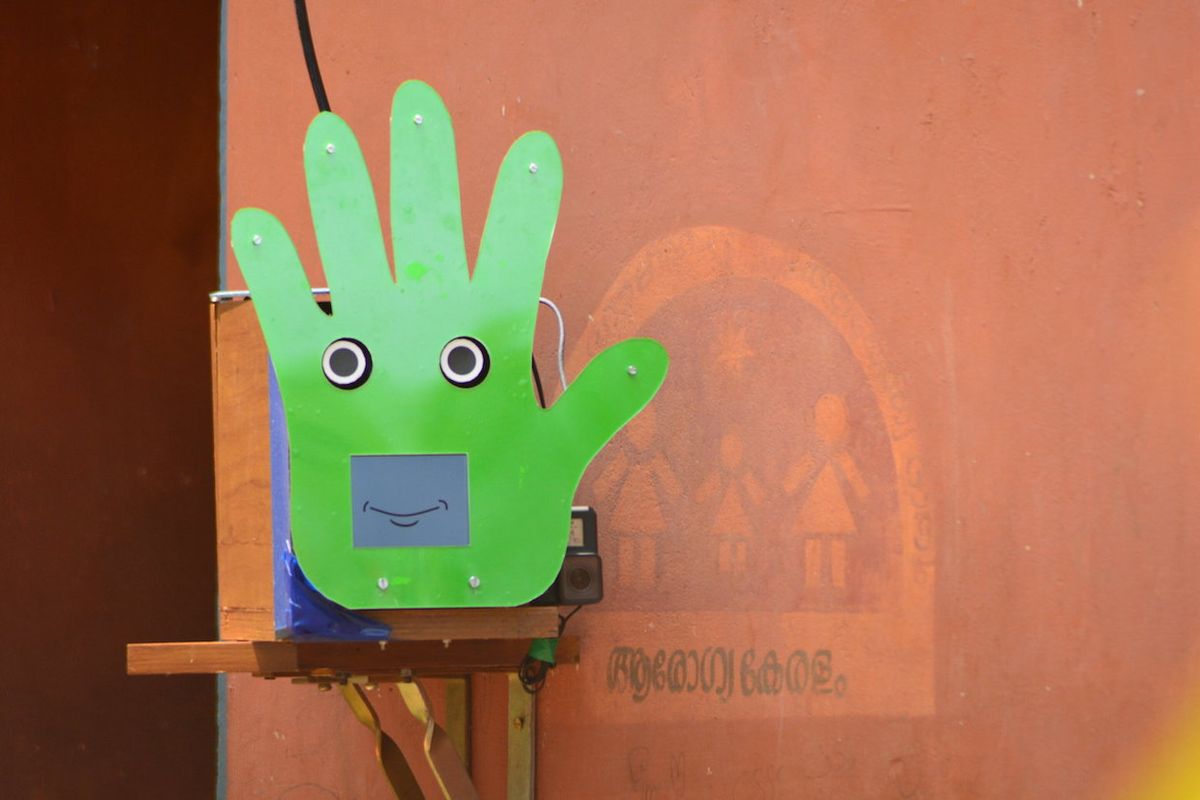Last Tuesday, October 15th, was Global Handwashing Day, which I’m sure you celebrated by washing your hands every time you were supposed to. Hand washing is a skill that can be difficult for kids to learn, because there usually aren’t immediate negative consequences to not washing your hands. The not immediate consequences can be severe, though—hand washing with soap can prevent 40 percent of diarrhea and respiratory infections, which kill about 1,300 young children around the world each day. Kids that don’t die can still get very sick, and about 443 million school days are lost globally each year due to water and sanitation related diseases in developing countries.
In rural India, only about 18 percent of people wash their hands with soap, and the way to change this is to start teaching hand washing as a skill at a young age. It’s especially important to do this in schools, which are both places for teaching things as well as places where diseases get transmitted (although hopefully more the first thing than the second thing). But we don’t want teachers spending their time standing by the bathroom sink nagging their pupils, and we don’t have to, because robots can help with this.
Amol Deshmukh, a researcher at the University of Glasgow whose work (in collaboration with Amrita University in India) using robots to transport water in rural villages in India we wrote about last year, has presented some new research last week on the development of a social robot that can encourage hand washing in rural Indian schools. The robot’s name is Pepe, and Deshmukh hopes that by just hanging out by the bathroom sink and doing some polite reminding, Pepe will be able to save kids’ lives.
Pepe is simple and inexpensive, as robots go. It’s made mostly out of acrylic since it’s cheap and looks shiny and clean. The bright green color was chosen because it’s associated with good health and the environment. The hand shape is self-explanatory, and the only moving parts are the two degree of freedom eyes, which are important because people are more likely to do things they know they should be doing when they think they’re being watched. They are being watched, of course, through a small front-facing camera that’s used for data collection.
A phone provides the screen for Pepe’s animated mouth, and the box that holds everything includes a speaker as well. Pepe’s name was carefully chosen (in consultation with local language experts) to be easy to pronounce and remember, but unfamiliar enough that the kids wouldn’t associate a gender with it. Pepe is able to speak the same language that the kids do (Malayalam), but not dynamically—the things it says are pre-recorded and tweaked to make them sound like a child with an indeterminate gender, and the robot is operated remotely by a researcher who tells it what to say and when. The whole thing costs less than US $100, and seems like it could easily be made for even less in volume.
Pepe’s job was to sit by the hand washing station at a school in rural India that hosts about 100 students ranging from 5 to 10 years old. Most of them (74 percent) had interacted with a smartphone before, but none of them had seen a robot. Pepe would remind the kids to wash their hands after using the restroom and before meals, talk them through the seven steps of proper hand washing (which you can view here if you’re trying to figure out what these seven steps could possibly be), and then say either “oh no” or “very good” depending on how the child did. It could also respond to a few other things, like “please don’t touch me” if a child got overly friendly.
The robot was only on station for three days, but it managed to increase hand washing rates by nearly 40 percent, and hand washing quality increased as well. Six days after the robot left the school, the researchers checked back, and found that while many students had gone back to their old habits, there was still a significant improvement in hygiene overall.
Part of what’s exciting about this research is seeing how humans and robots interact outside of the contexts that we’re used to. Here’s how the children responded when asked if they thought a different design might be good for the robot:
The [students] mentioned they would like it to be a cat’s face. The reason was they could take it home and pet it. When the interviewers asked if a dog’s face would also be appropriate, many of the students responded saying that they would not like that because dogs are considered unclean in their religion. Many of the students also commented that they had cats at home. Students with other religious backgrounds also agreed with this suggestion. This underscores the need for social robot design to take in cultural perceptions of form and symbolism.
A robot like Pepe seems like it could make a significant difference to hygiene in rural India and elsewhere, but the challenge will be to make it scalable. Having a human in the loop is obviously an issue if you want to deploy a whole bunch of these robots, so we asked Deshmukh why he didn’t start out with something more autonomous. “We wanted to pilot this robot as a proof-of-concept to investigate if such an application can be effective in this context and environment,” he said. “We did not know what results to expect but our research approach was systematic. We also wanted to identify the technical challenges for autonomous technology, for example computer vision in outdoor light sensitive and unstructured environments is still a technical challenge.” He added: “Our future goal is to build an autonomous system and deploy the robot in multiple schools, but this will require substantial funding and development effort.”
In order for the case to be made that these robots are worth that funding and development effort, you have to compare them to other methods of encouraging hand washing, like the bathroom posters that I can vaguely remember not paying attention to in elementary school.
Deshmukh says that the robot does a much better job. “Existing practices for influencing hand washing behavior in developing countries face three major challenges: 1. they are very resource intensive, 2. complex to measure/monitor compliance at scale due to unreliable self-reporting , and 3. they rarely are sustainable over long-term. Previous research on hand hygiene intervention suggests the disruption of the social and physical setting where the hand washing behavior should take place by placing eye-catching cues and visual reminders can lead to more successful interventions.” For that reason, he explained, “there is need for an interdisciplinary and innovative approach for influencing sustainable hand washing behavior. Social robots can, for example, encourage, remind, educate, give real-time feedback, observe, and monitor hand washing behavior, plus they are a distinct novelty for rural populations.”
For more details, we spoke with Amol Deshmukh via email.
IEEE Spectrum: What do you think was the most interesting part of your results?
Amol Deshmukh: The most interesting part about the study was the level of response we got from the students not just in terms of increase in levels hand washing but their interest in getting to know the robot. From the questionnaires response, 72 percent of the students thought it was alive (referring to its ability to talk as the main reason). The students tried to talk back to the robot, even sing not knowing that the robot cannot understand them. We also used this opportunity to engage with students, for example after the study finished a demonstration of the working of the robot was provided for 3rd and 4th grade students to encourage interest in the STEM disciplines.

Novelty is always a concern for social robots like these. Do you think that if the robot was left at the school long term, it would continue to be as effective?
In response to the question “Would you like to see Pepe back in the school after vacation?” we found that 97 percent of the (42) respondents indicated that they wanted to see the robot after a few months when their school re-opens. However traditionally human-robot interaction research has indicated users engagement levels with robots fades over a period of time. Our study was a short-term study in the future wen would like to deploy the robot over a long term period to investigate if the social robot will still be effective.
How could this robot be changed to make it more effective, especially long term?
In the long-term we would like to carry out research following a user centered design process, investigate which interactive strategies work better, for example use of gamification, if the children wash their hands effectively a time based graphic in relation to the hand washing steps completed can be shown on the screen (e.g. balloon bursts or a rocket fires) along with the robot showing a happy expression.
What are you working on next?
We want to develop the autonomous capabilities for the robot, by using machine learning to detect behavior cues—for example mutual gaze, hand washing activity along with effective verbal and non-verbal interaction strategies from the robot. Investigate the effectiveness of the social robot in influencing behavior change by objectively measuring hand washing activity such as quality, frequency, and duration using computer vision. We are seeking funding opportunities for carrying out this research effectively and deploy multiple robots at scale in rural schools in developing countries.
Deshmukh presented two papers on Pepe at the IEEE RO-MAN conference in New Delhi, India this week, along with colleagues from Ammachi Labs at Amrita University, including Unnikrishnan R, Sooraj K Babu, Shanker Ramesh, Parameswar Anitha, and Rao R. Bhavani.
Evan Ackerman is a senior editor at IEEE Spectrum. Since 2007, he has written over 6,000 articles on robotics and technology. He has a degree in Martian geology and is excellent at playing bagpipes.



